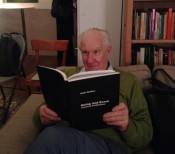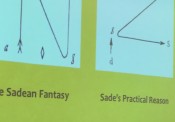Author: DasUnbehagen
Esther Sperber: The Shadow Of Zaha Hadid – Lilith Magazine
“…But alongside my admiration, and slight envy of Zaha Hadid, I hear a small ugly voice whispering in my head. This voice says, “she was too big for life and so she died.” It is true, I admit, that she defied so many social norms, being ambitious, creative and successful, and choosing not to marry or have children. This, the Trump-like-misogynist voice in my head says, was too much; t...
Manifesto Fest in DIVISION/Review
A group, including many Unbehagen members, presented a Manifesto Fest at the 2015 Division 39 Spring meeting in San Francisco. Click here to read the manifestos of Will Braun, Jill Gentile, Lynne Layton, Tiffany McLain, Tracy Morgan, Jonathan Shedler, Esther Sperber & Robert Stolorow, published in DIVISION/Review (posted with permission from DIVISION/Review).
Jamieson Webster: Speaking into the Void of the Unbehagen SalOon Listserv
DU tends to forget itself, which isn’t a bad thing. And the idea of DU, and its various allegiances, shift and grow and mutate which is a small miracle in often stuck communities. There are a lot of new people on the list serve, people who haven’t attended events, people who only know one another virtually, which is also a new situation. It is something of this new culture which I thin...
A Panel for the Launch of George Makari’s “Soul Machine: The Invention of the Modern Mind”
“Imagine a time in the future when your mind might travel. Perhaps it would enter a different torso or a foreign face. Would you still possess the same self, the same being? Our minds, most of us would agree, define us; they carry our personhood, and where they go, we go too. In Western culture, much depends upon this belief; it underpins a great deal of our literature, art, politics, and ju...
a/cephalic discontents: an event series curated by das unbehagen
“A dictionary begins when it no longer gives the meaning of words, but their tasks. Thus formless is not only an adjective having a given meaning, but a term that serves to bring things down in the world, generally requiring that each thing have its form. What it designates has no rights in any sense and gets itself squashed everywhere, like a spider or an earthworm. In fact, for academic me...
Double Entendre: Katy Bohinc, Rachael Wilson & Jamieson Webster respond to Alain Badiou
Wendy’s Subway presented performances and discussion of Bohinc’s “psycho-sexual thriller” Dear Alain, Webster’s The Life and Death of Psychoanalysis (Karnac Books, 2011), which addresses Badiou’s theory of love and asks how it may be conceived from the psychoanalyst’s discourse; and Wilson’s “Fifteen Theses,” on her artist’s book created from Badiou’s Being and Event to investigate the rhythms of...
Muriel Dimen: A Last-Minute Breakthrough – New York Times Couch
“Julia returned after the August vacation that we New York psychoanalysts customarily take. Well, not right after. She missed the first session. A family obligation, she said. Were I a traditional analyst, I might have wondered to myself: “Is there ambivalence here? Perhaps she doesn’t want to come back?” But I didn’t think that, or rather I ignored that flicker of doubt. I should have trust...
Dany Nobus: Writing as an Instrument of Torture – An Exploration of Sade’s Practical Reason via Lacan’s “Kant with Sade”
Of the twenty-eight substantial papers and six shorter contributions that make up Lacan’s Écrits, “Kant with Sade” is generally regarded as one of the toughest nuts to crack, and this opinion is shared by some of the most eminent and knowledgeable commentators on Lacan’s work. In this seminar, I will unpack one of the crucial lines of Lacan’s argument in “Kant with Sade”, notably that the contents...
Josh Cohen: Art, Psychoanalysis, Art and the Logic of Indifference
“As Leo Bersani and others have observed, there is a paradox at the heart of the Freudian corpus that animates and finally undoes it. In resisting the theoretical innovation of the death drive, Freud’s contemporaries were resisting an inner tendency of psychoanalysis to corrode the capacity of any stable concept to contain and master the forces it discloses. It’s with a certain poignancy of ...
Orna Shachar: The Therapeutic Gaze – New York Times Couch
“Daniel, a handsome 50-year-old whom I name the Marlboro Man because of his hyper-masculine looks and swagger, walks into my office and drops his body on the couch across from me. In a monotonous voice, his speech laced with obscenities, he announces his failure — his failure in life, in relationships with women, at work. He sits with his legs wide apart, as if penetrable, open and passive. ...
Evan Malater & Cecilia Wu: Pass the Porcupine – Freud, Porcupines and You
dear Porcupines, As an extra credit assignment following the Angelo Villa talk, Cecilia Wu and I became interested in the porcupine parable from Schopenhaeur that Angelo Villa offered towards the end of his presentation. Angelo used the parable to address the question of how a group might survive its narcissistic and hysteric tendencies, its craving for leadership and its hatred of leaders, its b...
Esther Sperber: The Architecture of Psychotherapy – New York Times Couch
“If you listen to psychotherapists when they talk to one another, you will often hear them speak of something called the “therapeutic frame.” This term, coined by the psychoanalyst Marion Milner, refers to the set of conventions and ground rules that structure the therapeutic experience. Just as the frame of a painting defines the borders of a work of art, the therapeutic frame is the “conta...























